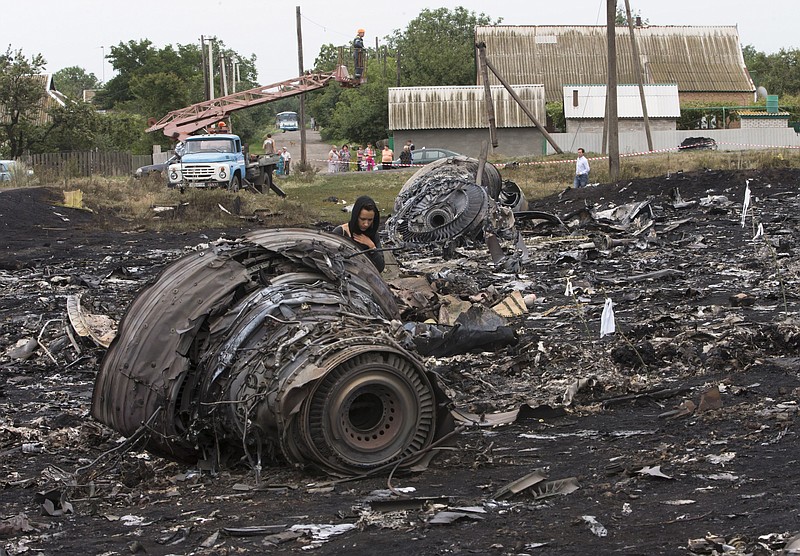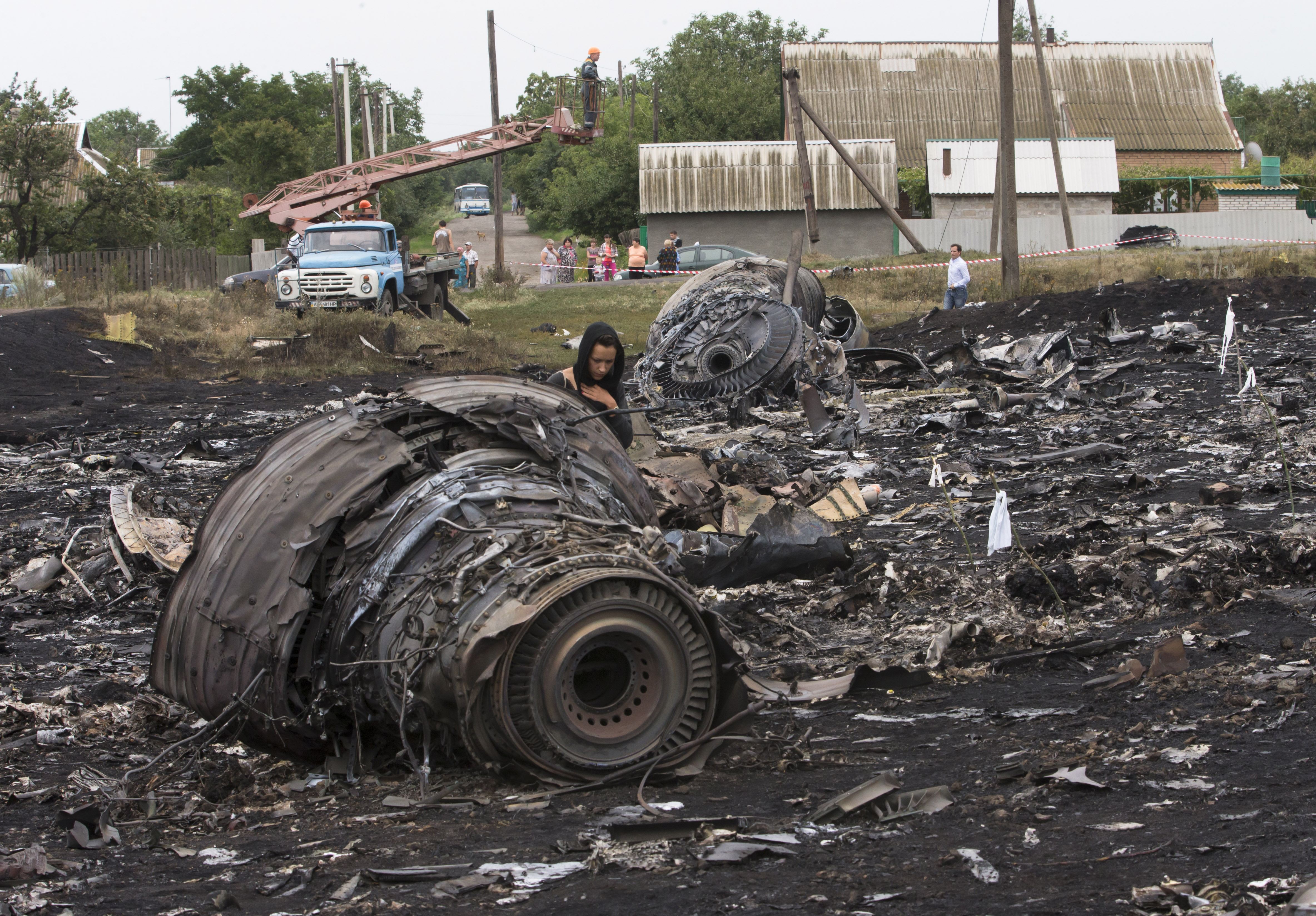WASHINGTON - he United States began building a case Friday that would pin the blame for the downing of the passenger jet over Ukraine on separatist forces supported by Russia, in a disaster that could dramatically escalate the crisis in Ukraine. President Barack Obama said one American was among the nearly 300 killed and called for an immediate cease-fire to allow for an unfettered investigation.
Evidence indicates that Malaysia Airlines Flight 17 was shot down by a surface-to-air missile from an area controlled by Russian-backed separatists, Obama said at the White House. He warned that the incident showed the crisis in Ukraine won't be localized or contained to the region.
"This should snap everybody's heads to attention," Obama said.
He identified the U.S. citizen who was killed as Quinn Lucas Schansman. No other details were available on the passenger.
While cautioning that the exact circumstances of the crash were still being determined, Obama pointed his finger at Russia for providing support to separatists that he suggested enabled them to shoot down the plane. He said such an attack wouldn't be possible without sophisticated equipment and training - "and that is coming from Russia."
"Obviously, we're beginning to draw some conclusions given the nature of the shot that was fired," Obama said in a stern address at the White House. "There are only certain types of anti-aircraft missiles that can reach up 30,000 feet and shoot down a passenger jet."
Officials from the FBI and the National Transportation Safety Board were on their way to Ukraine to help determine what happened, Obama said. He warned that evidence must not be tampered with as a United Nations-backed investigation goes forward, and he said, "We will hold all its members, including Russia, to their word" in allowing access to the crash.
At the United Nations earlier Friday, U.S. Ambassador Samantha Power delivered an extraordinary speech rebuking Russia and noting that the U.S. could not rule out that Russian personnel had assisted separatists in firing a missile at the plane.
"Russia can end this war," Power said. "Russia must end this war."
The National Transportation Safety Board said it was sending a single investigator to Ukraine as part of a U.S. delegation to assist with the investigation.
The White House has taken the lead in forming the U.S. delegation, according to an official familiar with the effort. A command center has been set up at the State Department, where officials from agencies participating in the delegation gathered Friday morning for a briefing from the CIA on the political and military situation in Ukraine, the official said.
A second U.S. official said all available evidence, including satellite imagery, pointed to the plane being shot down by an SA-11 anti-aircraft missile fired from eastern Ukraine by Ukrainian separatist forces. The U.S. detected three discrete events associated with the shootdown, the official said: the launching of the missile from the Ukraine side of the border, the missile's impact with the plane, and the plane slamming into the ground.
Both officials insisted on anonymity because they were not authorized to discuss U.S. intelligence matters publicly by name.
The attack Thursday afternoon killed 298 people from nearly a dozen nations, including vacationers, students and a large contingent of scientists. At least 189 of the dead were from the Netherlands.
The plane was shot down in eastern, Ukraine, near the border with Russia, in an area where Moscow's support for pro-Russian separatists has alarmed the U.S. and its European allies. The incident occurred one day after Obama announced broader economic sanctions against Russia for its threatening moves in Ukraine.
Previous story:
To figure out why a Malaysian jetliner fell from the sky, investigators will use the wreckage of any missile found to determine where it came from and who fired it, experts said Friday. That may be easier said than done in the middle of a war zone.
Investigators face formidable obstacles in deciphering a disaster scene spread over 20 square kilometers (eight square miles) of contested ground in eastern Ukraine - amid a conflict in which both sides have interests that may outweigh a desire to uncover the truth.
"We are in a country that is at war, and that is in a war of communication," aviation analyst Gerard Feldzer said in Paris. "Everyone is pushing a pawn."
All 283 passengers and 15 crew members aboard the Amsterdam-to-Kuala Lumpur flight were killed in Thursday's crash. U.S authorities and aviation experts say the Boeing 777 was likely brought down by a ground-to-air missile, but so far there is no proof of who fired it. Ukraine and the insurgents blame each other.
The U.S. ambassador to the United Nations, Samantha Power, said Washington believes the plane was likely downed by an SA-11 missile fired from an area controlled by pro-Russian separatists. She said Russia has provided SA-11s and other heavy weapons to the separatists.
The U.N. Security Council called Friday for "a full, thorough and independent international investigation" into the downing of the plane, but that is a complicated proposition.
Under international civil aviation rules, Ukraine should take the lead in investigating an airline accident on its territory. Anton Gerashenko, an adviser to Ukraine's interior minister, told The Associated Press that the investigation would be carried out by the Interior Ministry and the Security Services of Ukraine, who would work alongside international observers.
It was unclear what access either group would have to the crash site.
The Organization for Security and Cooperation in Europe sent a team of international monitors to the site, a swathe of smoldering wreckage and body parts near Ukraine's border with Russia, but they later reported only limited access to the wreckage.
European Union officials said Friday that Ukraine has first claim on the plane's two black boxes - a flight data recorder and a cockpit voice recorder - which could contain valuable clues about what happened in the moments before the crash.
An assistant to the insurgency's military commander said Friday that rebels had recovered multiple devices from the wreckage and were considering what to do with them, raising fears they could be headed to Moscow. But Russian Foreign Minister Sergey Lavrov said Russia had no intention of getting hold of the boxes, which he said should be given to the relevant international organizations. And insurgent leader Aleksandr Borodai later contradicted his colleague and said the rebels don't have them anyway.
Defense experts said the plane was likely shot down by a missile fired from a Buk system, Soviet-era equipment that is in the arsenals of both Russia and Ukraine. There was no previous evidence of separatist rebels using such missiles, though a rebel Twitter account boasted last month about seizing a Buk system from Ukrainian forces, and AP journalists saw such a system hours before the crash Thursday in rebel-held territory.
Feldzer, the air-accident expert, said investigators' goal would be to "find the debris of the missile in question and determine the trajectory." Once investigators reach the site, they should be able to discover whether the plane was hit by one or more missiles, and the size of the missile system involved.
But, he said, "that won't determine who did it," unless investigators can find a satellite photo or radar records of the missile.
Justin Bronk, a research analyst at the Royal United Services Institute, a London-based military think tank, said the United States has sophisticated military satellites capable of detecting a missile launch, but might be unwilling to share its images in order to protect its secret surveillance capabilities.
"They will probably try to liaise with civilian satellite operators to see if there are any who also picked up the trail on infra-red sensors so that they can publicly release that data," he said.
The crash site is vast, and experts said rebel fighters may have removed key evidence in the chaotic hours after the disaster, as they joined emergency workers and local coal miners to comb the wreckage and recover the bodies.
Charles Heyman, editor of "Armed Forces of the EU," said missile casings could help establish who had supplied the weapons that brought down the plane. But he said it was likely that the rebels - if they fired the missile - would have removed any missile-casing debris from the scene.
Heyman said the missile launcher would bear ID numbers that could establish whether it was recently supplied by Russia or came from Ukrainian forces.
But he said if rebels mistakenly targeted a commercial airliner, thinking it was a Ukrainian military plane, they may have subsequently fled and taken the missile launcher into Russia.
The Ukrainian Interior Ministry released video purporting to show exactly that: a truck carrying a Buk missile launcher with one of its four missiles apparently missing, rolling toward the Russian border. The ministry said the footage was captured by a police surveillance squad at dawn Friday. There was no way to independently verify that claim.
"If I was the rebel chief of staff, I'd have had it taken away, dismantled and blown up," Heyman said, "and then bury the pieces in a swamp."

